
From 2015 to 2025, the global financial market has gone through a tumultuous cycle. From the quantitative easing of the post-financial crisis era to the historic zero interest rate environment, and then to the sharp tightening cycle triggered by high inflation, the massive waves of the macro economy have continuously impacted various assets. In this context, cryptocurrency assets represented by BTC and ETH have far outperformed stocks, gold, and U.S. Treasury bonds, completing an astonishing leap from experimental products in the geek community to being included in the balance sheets of Wall Street institutions. However, the excess returns are accompanied by extreme risks—cryptocurrency assets have experienced drawdowns exceeding 75%, with recovery periods often measured in years, while traditional assets have shown greater resilience.
In this regard, the OKX Research Institute focuses on "The Performance of Five Major Assets Over 10 Years" to attempt to answer a key question: Over a 10-year time scale, how do BTC and ETH compare with mainstream assets such as gold, the S&P 500 index, and U.S. Treasury bonds in terms of their respective returns and risks? Have we paid a commensurate or even excessive risk price for the astonishing returns of cryptocurrency assets? To this end, we will go beyond a simple comparison of returns and strive to create a complete, objective, and cyclical asset performance map. (Statistical data is as of August 31, 2025)

Data Source: 8 MarketCap; As of the end of August 2025, Bitcoin has ranked among the top global assets by market capitalization.
Who is the King of Assets in the Return Battle?
The most intuitive way to assess an asset is to observe its long-term value growth trajectory. We assume an investment of $10,000 in these five assets on August 1, 2015, and track its cumulative value change until August 1, 2025. This comparison clearly reveals the significant differences in wealth creation capabilities among different asset classes.
(1) Annual Price Snapshot: Value Benchmark at Key Points (2015-2025, August 1 each year)
The table below records the closing prices of the five core assets on August 1 each year from 2015 to 2025 (or the first trading day thereafter).
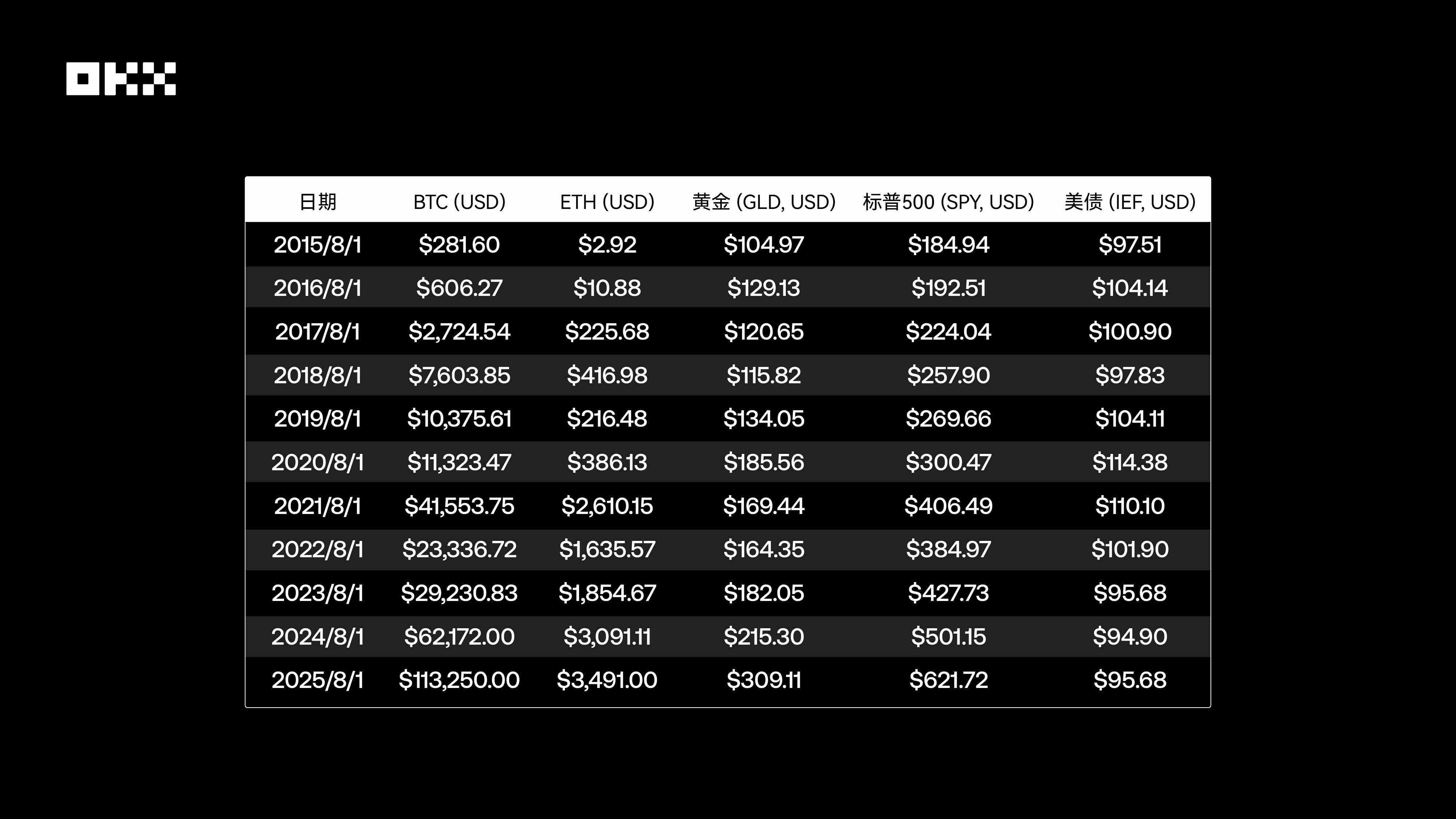
Data Source: Based on Yahoo Finance and CoinGecko, for the closing price on that day or the first trading day thereafter; ETF prices are adjusted closing prices.
From the price snapshots, it is clear that Bitcoin and Ethereum have experienced exponential growth, with their price magnitudes fundamentally changing over the decade. In contrast, the S&P 500 has shown a robust bullish trajectory, gold has exhibited fluctuations related to the macroeconomic cycle, and the price of U.S. Treasury bonds clearly reflects changes in the interest rate environment, facing significant pressure during the interest rate hike cycle of 2022-2023.
(2) Annual Peak Moments: Capturing the Highest Points of Each Cycle
Simply observing price snapshots on specific dates is far from sufficient to depict the full picture of an asset. Price fluctuations within the year, especially the occurrence of peak prices, reveal the potential explosiveness of the asset and the "fear of missing out" (FOMO) that traders may face. The table below summarizes the highest prices reached by each asset during each annual cycle (from August 1 of that year to July 31 of the following year).
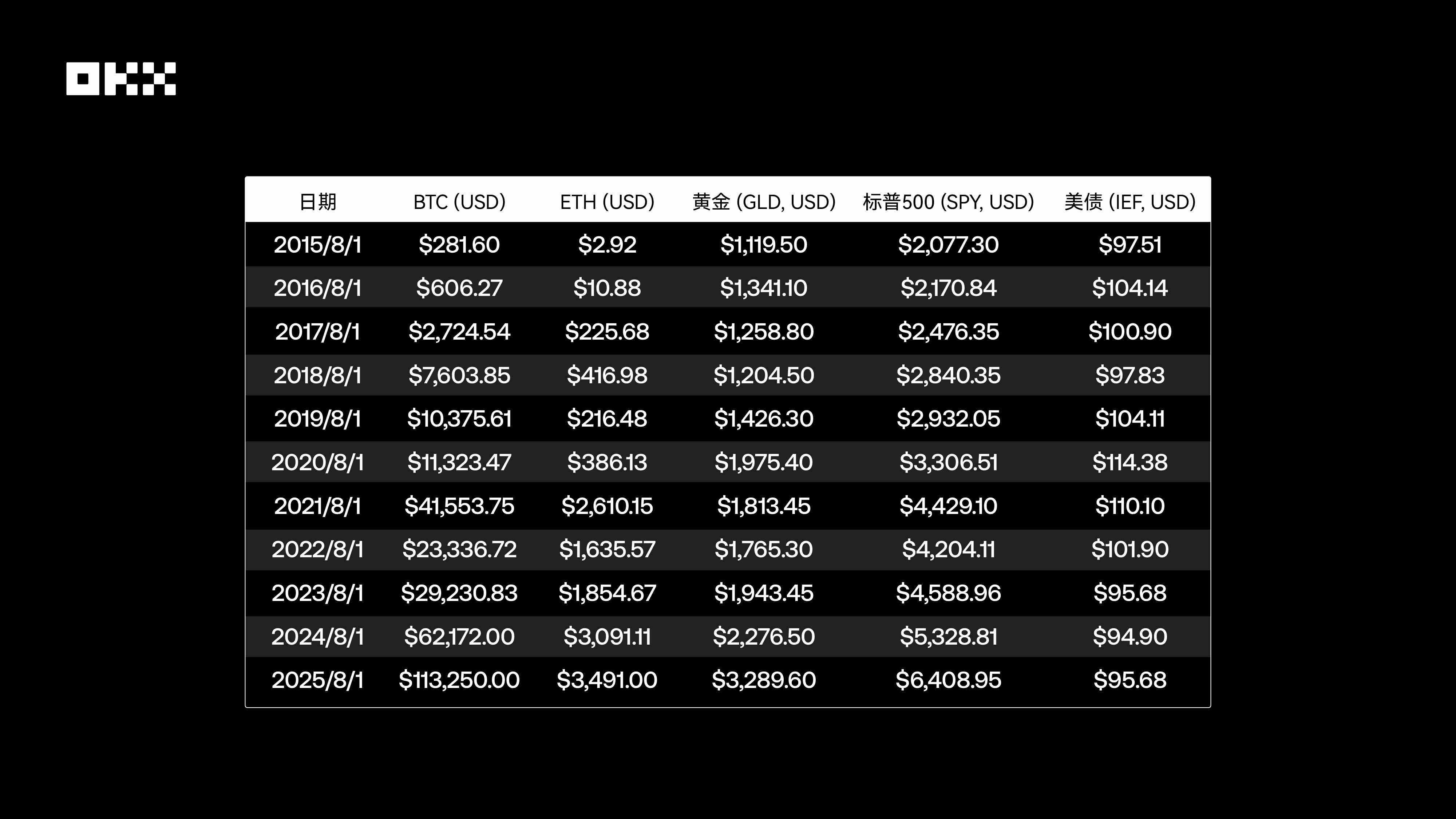
Data Source: Ethereum was launched on July 30, 2015, and early data may have low liquidity and certain inaccuracies; other data is based on daily historical data from Yahoo Finance.
By observing the price peaks each year, we can clearly see the differences in the magnitude of asset growth. Bitcoin and Ethereum's price peaks during bull markets show astonishing jumps, while the annual peak prices of the S&P 500 and gold have much smaller gaps compared to their snapshot prices, reflecting their more mature and stable market characteristics.
(3) Wealth Growth Simulation: A $10,000 10-Year Fantasy Drift
To more intuitively feel the wealth creation capabilities of different assets, we simulated a simple experiment: on August 1, 2015, $10,000 was invested in each of the five assets and held until August 1, 2025. The following chart displays the cumulative value change of this investment on a logarithmic scale, which better handles data with vastly different magnitudes, avoiding overly steep curves for high-growth assets that obscure details of other assets.
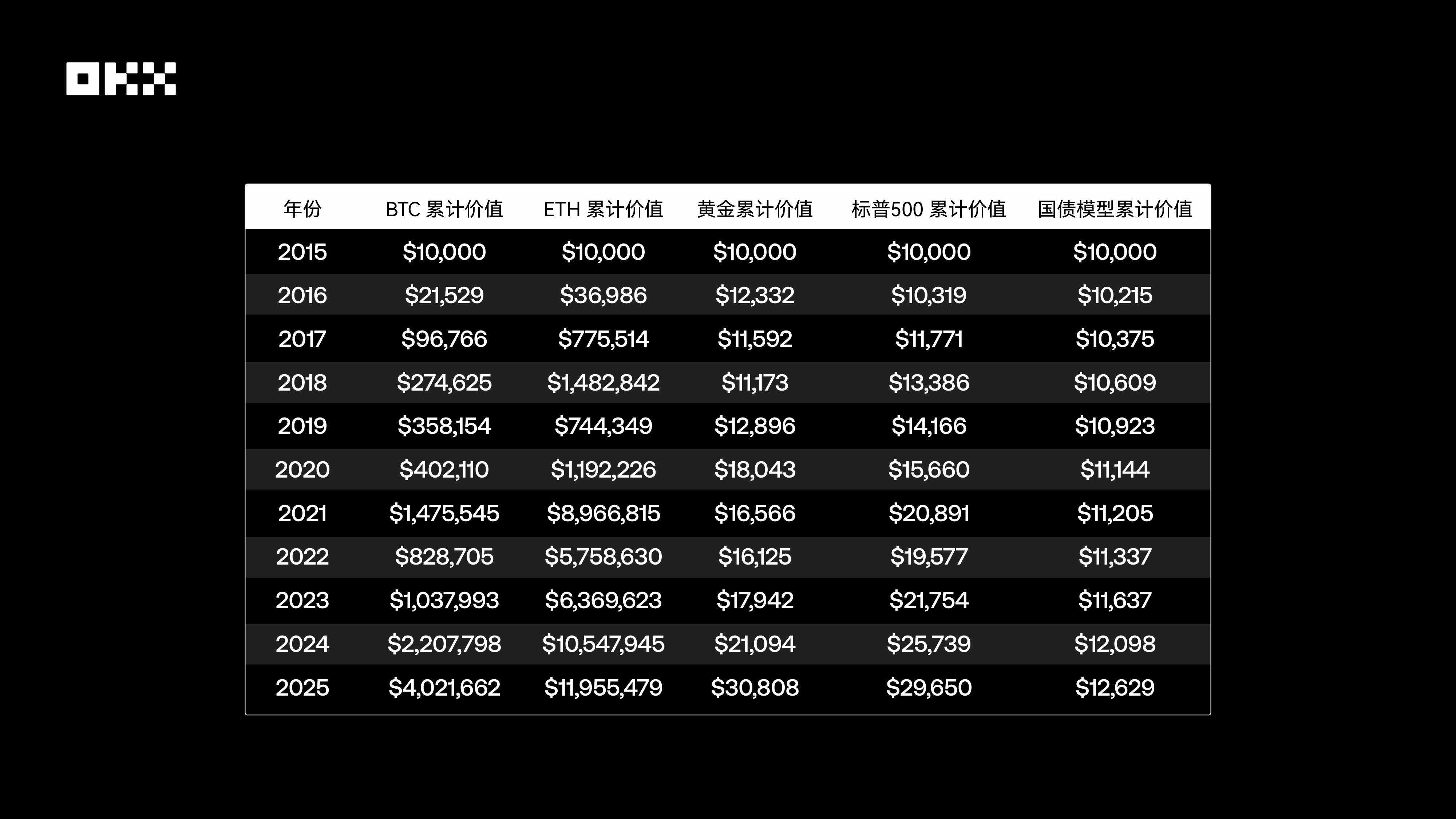
Data Source: Yahoo Finance, FRED, Macrotrends, etc.
The table shows that from 2015 to 2025, the growth multiples of different assets were: BTC 402.17 times, with a 10-year cumulative return of approximately $4.02 million; ETH 1195.55 times, with a 10-year cumulative return of approximately $11.95 million; gold 3.08 times, with a 10-year cumulative return of approximately $30,000; S&P 500 2.97 times, with a 10-year cumulative return of approximately $29,600; U.S. Treasury bonds 1.26 times, with a 10-year cumulative return of only about $12,600.
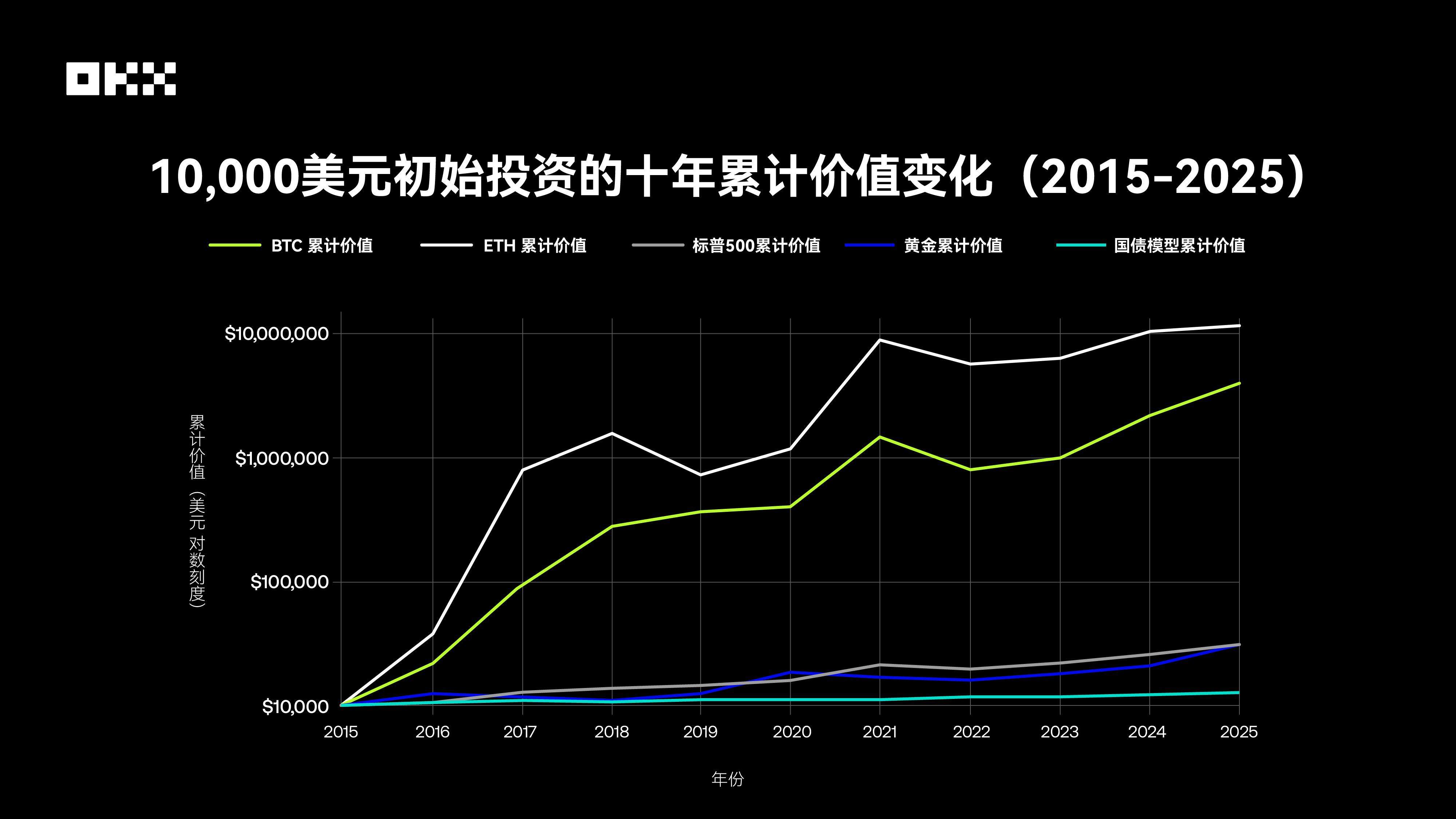
Among them, Bitcoin and Ethereum demonstrate an astonishing wealth growth effect, with returns far exceeding traditional assets, reaching hundreds or even thousands of times, reflecting the asymmetric return potential of emerging technology assets under high risk, which is unimaginable in the traditional financial world. In contrast, the S&P 500 has tripled its investment through stable compound growth, gold has primarily played a role in value preservation, while U.S. Treasury bonds have nearly stagnated over the decade after experiencing both low and high interest rate cycles, highlighting the constraints of interest rate risk on the long-term performance of bond assets.
Maximum Drawdown: How High is the Risk Behind the Returns?
No asset can lead forever; return rates are just the beginning of the story. A mature trading user is more concerned about the quality of returns—that is, how much risk was taken to achieve these returns—so understanding the risk characteristics of different assets is as important as understanding their return potential. By using three core indicators: volatility, maximum drawdown, and Sharpe ratio, we can more comprehensively assess the true "cost-performance ratio" of various assets. Volatility is typically measured by standard deviation, reflecting the amplitude of asset price fluctuations. Maximum drawdown measures the maximum decline of an asset from its historical peak to the subsequent lowest point, serving as an intuitive indicator of downside risk, directly related to the psychological tolerance limits of trading users and the survival ability of asset portfolios.

Data Source: Bloomberg, S&P Global, Yahoo Finance, etc.
The volatility of cryptocurrency assets far exceeds that of traditional assets. According to Digital One Agency data, Bitcoin's annualized standard deviation is about 70%-90%, while the S&P 500 index is only 15%-20%. This enormous volatility directly leads to astonishing maximum drawdowns: over the past 10 years, Bitcoin and Ethereum have experienced multiple drawdowns exceeding 70%. For example, during the bear market of 2018, the price of BTC fell from nearly $20,000 to about $3,000, with a drawdown exceeding 80%. The largest drawdown for the S&P 500 occurred in early 2020 during the COVID-19 pandemic, at about -34%. During the historical financial crisis of 2008, the drawdown exceeded 50%. Gold has shown relatively stable performance, with a maximum drawdown of about -29% over the past 15 years. As a safe-haven asset, U.S. Treasury bonds have the smallest drawdown, but due to the impact of the interest rate cycle, they also experienced a maximum drawdown of about -23% during the interest rate hike cycle after 2020, breaking the myth of "risk-free."
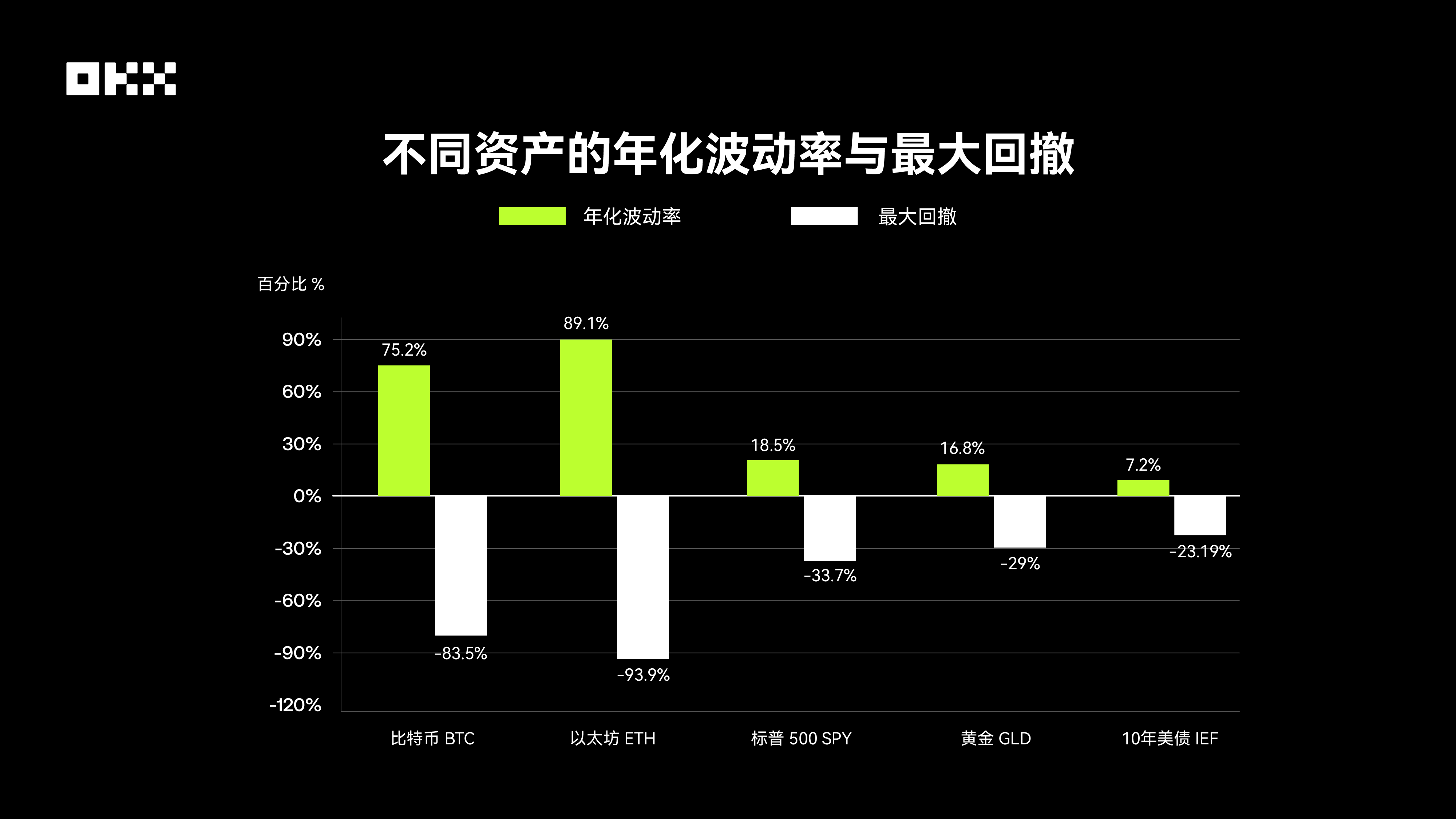
This data is alarming. Users of Bitcoin and Ethereum must be able to withstand asset shrinkage of over 80% or even 90%, and they need to wait more than two to three years to break even.
Furthermore, to comprehensively assess risk and return, we also introduced the Sharpe ratio and Calmar ratio. The Sharpe ratio, proposed by Nobel laureate William Sharpe, is the most classic risk-adjusted return indicator internationally. It measures how much excess return over the risk-free rate a user can obtain for each additional unit of total risk (measured by volatility) taken. The higher the Sharpe ratio, the better the asset's return performance under the same risk, indicating higher trading efficiency.
The Calmar ratio is another important risk-adjusted return indicator, but it focuses more on measuring the downside risk of an asset. It is calculated as the ratio of annualized return to historical maximum drawdown. A higher Calmar ratio means that the asset has a stronger "recovery ability" or "cost-performance ratio" when facing the worst historical drawdowns. This indicator is particularly favored by users who emphasize risk control.
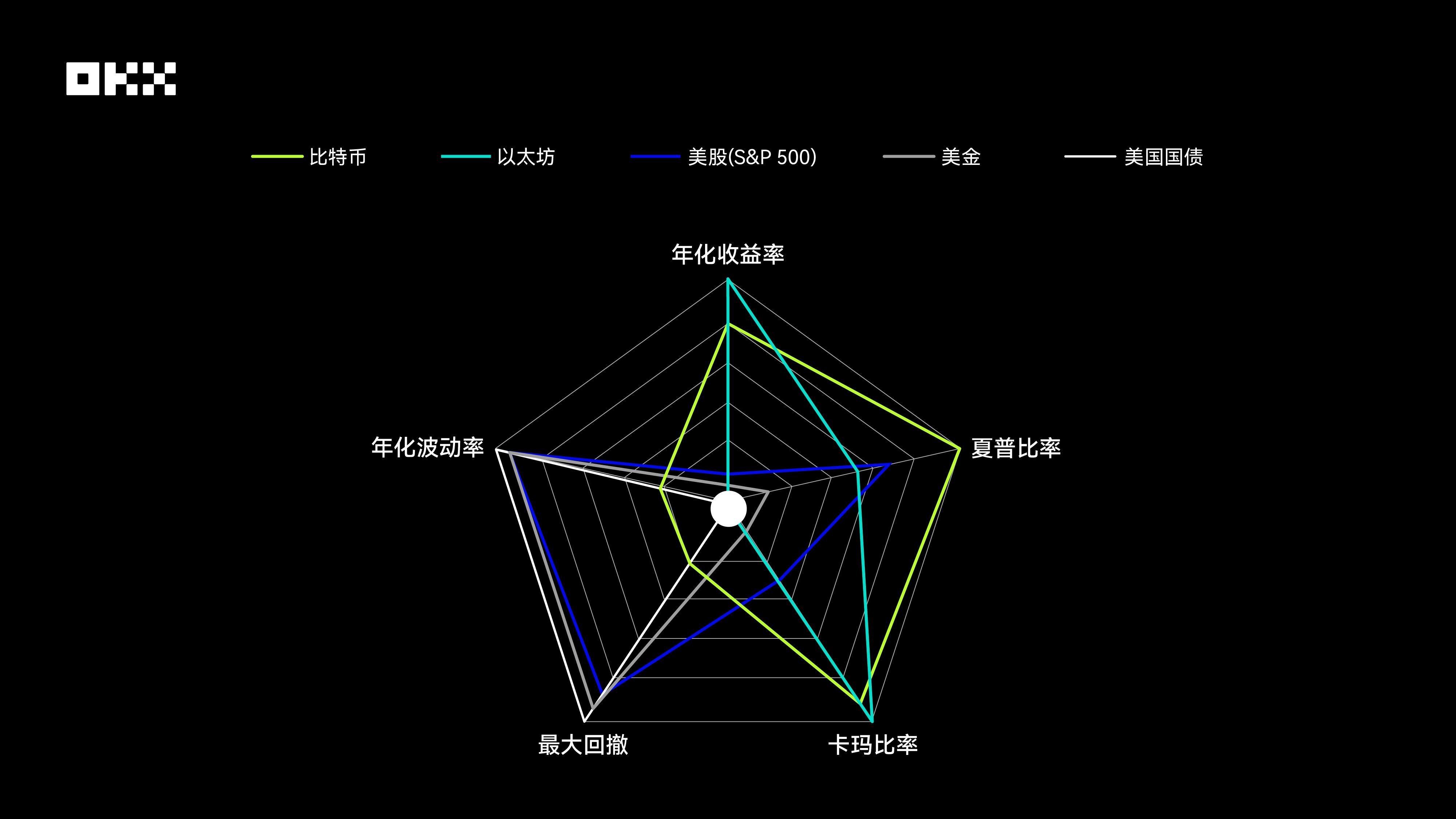
The radar chart for Bitcoin and Ethereum is the most "aggressive." They show unparalleled advantages in both annualized return and Calmar ratio dimensions, forming two outward spikes, reflecting their astonishing wealth growth effects and strong recovery capabilities after drawdowns over the past decade. However, such high returns do not come without a cost. In terms of maximum drawdown and annualized volatility, their scores are the lowest among all assets, indicating that their shapes are severely constricted in these two directions, forming a clear "shortcoming." This clearly reveals the high-risk, high-volatility nature of cryptocurrency assets. Notably, Bitcoin's Sharpe ratio outperforms that of Ethereum, indicating that Bitcoin has slightly better investment efficiency when adjusted for risk.
The radar chart for the S&P 500 presents a relatively balanced pentagon with a considerable coverage area. It does not exhibit significant weaknesses across all five dimensions, nor does it have extreme strengths. Its Sharpe ratio is outstanding, second only to Bitcoin, indicating excellent risk-adjusted returns. At the same time, it has a robust annualized return, with volatility and maximum drawdown well controlled, far superior to cryptocurrency assets. This depicts a typical "mainstay" image: capable of providing substantial long-term returns while keeping risks within a relatively reasonable range, making it a cornerstone for building an asset portfolio.
The radar chart for gold leans towards the risk control dimension. It scores high in annualized volatility and maximum drawdown, indicating that its price is relatively stable and resilient to declines. However, in the three return-related dimensions of annualized return, Sharpe ratio, and Calmar ratio, gold's performance is relatively mediocre. This aligns perfectly with gold's positioning as a traditional safe-haven asset: it is not a tool for pursuing high growth but rather serves to provide value storage and hedge against risks during market turmoil. Its smaller chart area also reflects its lower overall return efficiency.
The radar chart for U.S. Treasury bonds has the smallest area among all assets, with a shape tightly constricted towards the center. It scores the highest in both annualized volatility and maximum drawdown, demonstrating extreme stability. However, it ranks at the bottom in all return-related dimensions. This clearly indicates that, in the macro context of declining interest rates over the past decade, U.S. Treasury bonds primarily played the role of capital preservation and liquidity provision, serving as a "ballast" in asset portfolios rather than a return engine. Its extremely low risk and extremely low return create a stark contrast.
Asset Correlation: How to Optimize Asset Portfolios?
The core of portfolio diversification lies in including assets with low correlation. When one asset declines, another may rise or remain stable, smoothing the overall volatility of the portfolio. At the inception of Bitcoin, it had almost no correlation with traditional financial markets and was seen as a perfect "diversification tool." However, this characteristic has changed significantly over the past decade, especially after the acceleration of institutionalization.
The correlation coefficient measures the degree to which the prices of two assets move in the same direction, ranging from -1 (perfectly negatively correlated) to +1 (perfectly positively correlated). An effective diversified portfolio is typically composed of low or negatively correlated assets. The table below summarizes data from multiple research institutions, showcasing the approximate correlations among various assets over the past decade.

Data Source: Crypto Research Report, LSEG, Newhedge
Bitcoin vs. S&P 500: From Independence to Synchronization. This is one of the most significant changes over the decade. Before 2020: The correlation between cryptocurrency assets and traditional assets was generally low and unstable, often fluctuating between positive and negative, demonstrating strong independence. 2020-2021: During the pandemic and monetary easing period, as global central banks implemented massive liquidity injections, the "rising tide lifts all boats" effect for all risk assets became significant. During this period, the correlation between Bitcoin and the S&P 500 (especially tech stocks) surged sharply, at one point exceeding 0.6, showing a strong "coupling" phenomenon. This indicates that in a macro liquidity-driven market, Bitcoin behaves more like a high Beta risk asset rather than a safe-haven tool.
2022-2023: With the interest rate hike and tightening cycle, as the Federal Reserve initiated an aggressive rate hike cycle to combat inflation, risk assets generally came under pressure. The correlation between Bitcoin and the S&P 500 remained high, both declining together. However, its negative correlation with the U.S. Dollar Index (DXY) significantly increased, with Bitcoin prices often under pressure when the dollar strengthened. 2024-2025: The ETF Era, the approval of U.S. spot Bitcoin ETFs is seen as a structural turning point. On one hand, it strengthens the connection between the crypto market and the traditional financial system; on the other hand, the continuous inflow of funds brought by ETFs may become a pricing factor independent of macro sentiment, leading to changes in correlation again. Data shows that after the approval of ETFs, the correlation between Bitcoin and the S&P 500 decreased, indicating some signs of "decoupling."
Bitcoin vs. Gold: The Challenge of the "Digital Gold" Narrative. Although Bitcoin is hailed as "digital gold" due to its fixed supply, data shows that its correlation with the safe-haven properties of real gold is not stable. Research from the European Securities and Markets Authority (ESMA) points out that there is no clear stable relationship between the two, especially during market panic, when Bitcoin often declines alongside risk assets rather than providing shelter like gold.
Internal Relationships of Traditional Assets: The classic negative or low correlation between gold, U.S. Treasury bonds, and the S&P 500 remains the cornerstone of traditional asset allocation, providing important stability for asset portfolios.
How Do Major Events Impact the Performance of the Five Assets?
Averages over long periods may obscure extreme performances at key moments. By conducting "slice" analyses of several major events, we can gain a deeper understanding of the true "stress responses" of various assets.
(1) March 2020: The COVID-19 Black Swan Event, Indiscriminate Sell-off in Global Markets
In March 2020, the COVID-19 pandemic triggered panic in global financial markets, known as "Black March." In this extreme liquidity crisis, almost all assets faced indiscriminate sell-offs. The S&P 500 index fell into a bear market in just 16 trading days, setting a record for the fastest decline in history, with a maximum drawdown of -34%. Bitcoin also did not escape, with its price plummeting nearly 50% in one day on March 12, dropping from about $8,000 to below $4,000. Gold (GLD) also could not fully escape, declining temporarily as users sold assets for dollar liquidity. Only U.S. Treasury bonds remained strong as the ultimate safe haven. This event profoundly revealed that in extreme "de-risking" phases, correlations tend to converge to 1, and Bitcoin's narrative as a "digital safe haven" crumbled in the face of liquidity exhaustion.
(2) May & November 2022: The Crypto-native Crisis, LUNA & FTX Collapse Brings Devastating Blow
2022 was the "disaster year" for the crypto industry. In May, the collapse of the algorithmic stablecoin TerraUSD (UST) and its sister token LUNA wiped out nearly $50 billion in market value within days. In November of the same year, the sudden bankruptcy of the world's second-largest crypto exchange, FTX, further exacerbated market panic. These two events are typical examples of "endogenous" crises in crypto. Research shows that after the FTX collapse, both Bitcoin and Ethereum prices fell by over 20%, while assets closely related to the FTX ecosystem experienced even larger declines. However, during these events, traditional financial markets, including gold, the S&P 500, and U.S. Treasury bonds, were hardly affected, clearly demonstrating the risk isolation between the crypto market and traditional finance. This indicates that crypto assets face not only macroeconomic risks but also unique, potentially more devastating internal protocol, platform, and trust risks.
(3) 2020-2025: The Shift in Macro Policy Cycle, The Tides of Liquidity
The Federal Reserve's monetary policy is the "master valve" of global liquidity. Under the massive quantitative easing and zero interest rate policies of 2020-2021, abundant liquidity flowed into risk assets, leading to bull markets for both Bitcoin and the S&P 500. However, since March 2022, when the Federal Reserve began an aggressive rate hike cycle to combat inflation, global liquidity has tightened, and risk asset prices have fallen in response. Academic research indicates that Bitcoin's price sensitivity to Federal Reserve interest rate decisions and monetary policy uncertainty (MPU) significantly increased after 2020. This further confirms that Bitcoin has deeply integrated into the macro-financial framework, with its price fluctuations closely tied to the Fed's policy expectations.
Additionally, research has found that the Bitcoin market exhibits significant "anticipatory trading" characteristics. Before interest rate decisions are announced, the market often has already priced in the rate hike expectations, putting downward pressure on Bitcoin prices; conversely, when there is strong anticipation of rate cuts, prices tend to rise in advance. On the day of the announcement, if the outcome meets expectations, the market reaction is usually muted. The real volatility comes from "rate surprises"—when the FOMC's decision deviates from the market's expectations priced through interest rate futures and other tools.
The following chart shows the average cumulative abnormal return (CAR) of Bitcoin relative to the S&P 500 during the interest rate hike and cut event windows (T-5 to T+5 days). It can be seen that during the rate cut cycle, Bitcoin shows significant positive abnormal returns before the decision is announced, while during the rate hike cycle, this is not evident and may even be negative. This indicates that the market reacts more positively and in advance to rate cuts.

(4) January 2024: Approval of Bitcoin Spot ETF, A Milestone Towards Mainstream Adoption
On January 10, 2024, the U.S. Securities and Exchange Commission (SEC) officially approved the listing of the first Bitcoin spot ETFs, regarded as a milestone event for the legalization and mainstreaming of crypto assets. The launch of ETFs significantly lowers the barriers for traditional users to access Bitcoin. Data shows that after the approval of ETFs, Bitcoin trading volume surged, with strong capital inflows. Charts from Chainalysis indicate that after the ETF launch, its daily trading volume approached $10 billion in March, with cumulative capital inflow rates far exceeding those seen during the launch of the first gold ETF in 2005. This event not only propelled Bitcoin prices to new highs but, more importantly, is structurally changing Bitcoin's user base and market dynamics, making its connection to the traditional financial system closer than ever.
There Are No Perfect Assets: Building a Portfolio That Endures Through Cycles
BTC/ETH are the undisputed "kings of growth" over the past decade, providing extraordinarily high returns unmatched by any traditional asset. However, the price of this return is extreme volatility and significant drawdowns. Their correlation with traditional markets is increasing, diminishing their value as pure diversification tools. They are suitable for users with extremely high risk tolerance and a belief in long-term holding.
The S&P 500 serves as the "ballast" for long-term asset portfolios. It offers excellent, sustainable compound growth, and in terms of risk-adjusted returns, it exhibits the best balance in both Sharpe and Calmar ratios. While it may experience periodic corrections, its strong recovery ability and the support of the underlying real economy make it the absolute core for building asset portfolios.
Gold, as an ancient means of value storage, has limited absolute returns, but remains an indispensable "insurance policy" during times of macro uncertainty, geopolitical risks, and challenges to the credit currency system. Its value in an asset portfolio lies not in offense but in defense.
U.S. Treasury bonds, traditionally regarded as a "safe haven," have faced severe challenges during an unprecedented interest rate hike cycle, reminding users that "risk-free" is merely a relative concept. Nevertheless, they remain one of the most liquid and highest-rated assets globally, providing a foundational role of stability and liquidity in asset portfolios that is difficult to replace in the short term.
Thus, this classic question also has an answer: Should one choose a dollar-cost averaging strategy or a lump-sum investment strategy?
In the long run, for high-volatility assets (BTC/ETH), a dollar-cost averaging strategy shows significant advantages. By buying more shares at price lows, dollar-cost averaging effectively smooths costs, reduces timing risks, and ultimately achieves very considerable returns, with much less psychological pressure during the process compared to a lump-sum investment.
For stable growth assets (SPY), due to the long-term upward trend of the stock market, a lump-sum investment strategy has historically outperformed dollar-cost averaging for most of the time, as it allows funds to enjoy the market's compound growth earlier and more fully.
For low-growth assets (GLD/IEF), the final results of the two strategies show little difference, as neither has produced explosive returns. The conclusion is that dollar-cost averaging is an effective strategy for navigating high-volatility assets like Bitcoin, while for the long-term stable growth equity market, an early lump-sum investment is usually the better choice. Whether you prefer a basic dollar-cost averaging strategy, an intelligent arbitrage strategy, a grid strategy suitable for short-term trading, or advanced signal or iceberg strategies, OKX strategy trading can meet your needs in one stop.
The "holy grail" of asset allocation is not to find a single best asset, but to deeply understand and cleverly combine the unique characteristics of different assets. A robust asset portfolio should leverage the sharpness of crypto assets to seek excess returns, rely on the thickness of equity assets to drive long-term growth, and allocate gold and bonds for stability to guard against unknown risks. Ten years of data tell us: the market is always evolving, and there are no eternal winners. The true "king of assets" may not exist within any specific asset but rather within a rational trading framework that can deeply understand and navigate the characteristics of different assets.
Disclaimer:
This article is for reference only. It represents the author's views and does not reflect the position of OKX. This article does not intend to provide (i) investment advice or recommendations; (ii) offers or solicitations to buy, sell, or hold digital assets; (iii) financial, accounting, legal, or tax advice. We do not guarantee the accuracy, completeness, or usefulness of such information. Holding digital assets (including stablecoins and NFTs) involves high risks and may fluctuate significantly. Past performance does not guarantee future results, and historical returns do not represent future outcomes. You should carefully consider whether trading or holding digital assets is suitable for you based on your financial situation. Please consult your legal/tax/investment professionals regarding your specific circumstances. You are responsible for understanding and complying with applicable local laws and regulations.
免责声明:本文章仅代表作者个人观点,不代表本平台的立场和观点。本文章仅供信息分享,不构成对任何人的任何投资建议。用户与作者之间的任何争议,与本平台无关。如网页中刊载的文章或图片涉及侵权,请提供相关的权利证明和身份证明发送邮件到support@aicoin.com,本平台相关工作人员将会进行核查。




